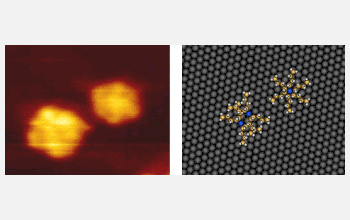 Pictured here is a stationary (left)
versus a spinning (right) rotor molecule. At very low temperatures (close to
absolute zero) it is possible to stop the rotation of molecules because the
molecules do not have enough energy to spin. Energy applied to the stationary
molecule in the form of heat or electrical current can induce rotation. When
supplied with energy, the molecule will spin around a central axle, similar to
a propeller. In the bottom-left corner of each image are schematics. In this
schematic, blue=sulfur, yellow=carbon, white=hydrogen and gray=gold atoms.
Pictured here is a stationary (left)
versus a spinning (right) rotor molecule. At very low temperatures (close to
absolute zero) it is possible to stop the rotation of molecules because the
molecules do not have enough energy to spin. Energy applied to the stationary
molecule in the form of heat or electrical current can induce rotation. When
supplied with energy, the molecule will spin around a central axle, similar to
a propeller. In the bottom-left corner of each image are schematics. In this
schematic, blue=sulfur, yellow=carbon, white=hydrogen and gray=gold atoms.
On the left is a still from a scanning
tunneling microscope (STM) movie showing what happens when a single molecule
moves to close to a chain of molecules. A schematic representation of what is
happening in the STM movie is shown on the right.
 In the schematic representation, a
single molecule (on the right) rotates very close to a chain of two molecules
(on the left). After a few frames, the rotor moves toward the chain. The
molecules in the chain begin to interact with the rotor, and rotation of the
single molecule is hindered. After a few more frames the spinning molecule is
pulled onto the chain and it stops spinning altogether. In the schematic,
blue=sulfur, yellow=carbon, white=hydrogen and gray=gold atoms. [Note: Each
frame in the movie took ~2 minutes to acquire.]
In the schematic representation, a
single molecule (on the right) rotates very close to a chain of two molecules
(on the left). After a few frames, the rotor moves toward the chain. The
molecules in the chain begin to interact with the rotor, and rotation of the
single molecule is hindered. After a few more frames the spinning molecule is
pulled onto the chain and it stops spinning altogether. In the schematic,
blue=sulfur, yellow=carbon, white=hydrogen and gray=gold atoms. [Note: Each
frame in the movie took ~2 minutes to acquire.]
This research, supported by a grant from
the National Science Foundation (CHE 08-44343), was conducted in the lab of
Professor E. Charles H. Sykes in the chemistry department at Tufts University.
For further information about this research, including a video, visit
http://ase.tufts.edu/chemistry/sykes/Sykes%20Lab%20Research%20Group.html.
More About This Image
As devices become smaller and smaller, moving
parts are needed on a more miniature (nano) size scale. One such component that
will be required to build nanoscale machines is the rotor. Just as gears and
ratchets are used in everyday life to produce motion, making nanoscale
counterparts will be a crucial step towards building tiny machines out of
molecules. These nanomachines can be found throughout our bodies in the form of
proteins, which complete tasks such as cellular motion or muscle contraction.
However, very little is known about how to harness the motion of individual
molecules in order to perform similar tasks.
Professor Sykes has found a group of
molecules with which to study the basic properties and mechanics of rotation.
In order to turn a rotor into a useful machine, Sykes' group will need to be
able to use a fuel source to drive mechanical motion. Their molecular rotors
can be spun using heat or an electrical current as the fuel. While heat
provides an easy source of energy, rotation by this method is random and
uncontrollable. However, recently Sykes found that by exciting vibrations of
the chemical bonds between individual atoms, it is possible to rotate molecules
on command. This capability will make the complicated task of powering
nanomachines much easier for future studies of directed motion.
(Date of Images: 2007-2009)
Credit: Heather L. Tierney, April D.
Jewell and E. Charles H. Sykes, Chemistry Department, Tufts University






No comments:
Post a Comment